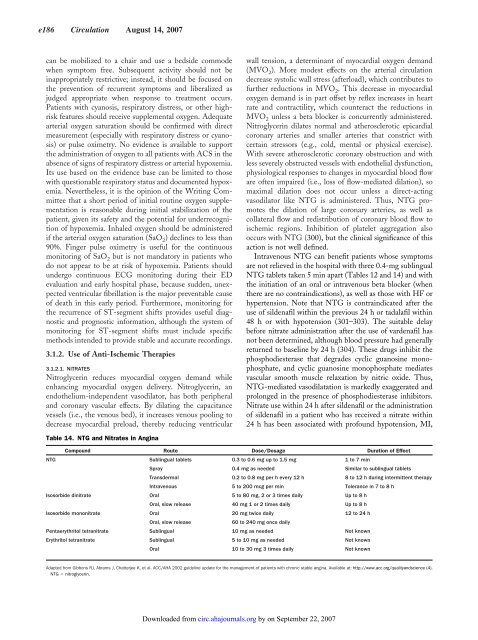ACC/AHA 2007 guideline update for the
ACC/AHA 2007 guideline update for the
ACC/AHA 2007 guideline update for the
You also want an ePaper? Increase the reach of your titles
YUMPU automatically turns print PDFs into web optimized ePapers that Google loves.
e186 Circulation August 14, <strong>2007</strong><br />
can be mobilized to a chair and use a bedside commode<br />
when symptom free. Subsequent activity should not be<br />
inappropriately restrictive; instead, it should be focused on<br />
<strong>the</strong> prevention of recurrent symptoms and liberalized as<br />
judged appropriate when response to treatment occurs.<br />
Patients with cyanosis, respiratory distress, or o<strong>the</strong>r highrisk<br />
features should receive supplemental oxygen. Adequate<br />
arterial oxygen saturation should be confirmed with direct<br />
measurement (especially with respiratory distress or cyanosis)<br />
or pulse oximetry. No evidence is available to support<br />
<strong>the</strong> administration of oxygen to all patients with ACS in <strong>the</strong><br />
absence of signs of respiratory distress or arterial hypoxemia.<br />
Its use based on <strong>the</strong> evidence base can be limited to those<br />
with questionable respiratory status and documented hypoxemia.<br />
Never<strong>the</strong>less, it is <strong>the</strong> opinion of <strong>the</strong> Writing Committee<br />
that a short period of initial routine oxygen supplementation<br />
is reasonable during initial stabilization of <strong>the</strong><br />
patient, given its safety and <strong>the</strong> potential <strong>for</strong> underrecognition<br />
of hypoxemia. Inhaled oxygen should be administered<br />
if <strong>the</strong> arterial oxygen saturation (SaO2) declines to less than<br />
90%. Finger pulse oximetry is useful <strong>for</strong> <strong>the</strong> continuous<br />
monitoring of SaO2 but is not mandatory in patients who<br />
do not appear to be at risk of hypoxemia. Patients should<br />
undergo continuous ECG monitoring during <strong>the</strong>ir ED<br />
evaluation and early hospital phase, because sudden, unexpected<br />
ventricular fibrillation is <strong>the</strong> major preventable cause<br />
of death in this early period. Fur<strong>the</strong>rmore, monitoring <strong>for</strong><br />
<strong>the</strong> recurrence of ST-segment shifts provides useful diagnostic<br />
and prognostic in<strong>for</strong>mation, although <strong>the</strong> system of<br />
monitoring <strong>for</strong> ST-segment shifts must include specific<br />
methods intended to provide stable and accurate recordings.<br />
3.1.2. Use of Anti-Ischemic Therapies<br />
3.1.2.1. NITRATES<br />
Nitroglycerin reduces myocardial oxygen demand while<br />
enhancing myocardial oxygen delivery. Nitroglycerin, an<br />
endo<strong>the</strong>lium-independent vasodilator, has both peripheral<br />
and coronary vascular effects. By dilating <strong>the</strong> capacitance<br />
vessels (i.e., <strong>the</strong> venous bed), it increases venous pooling to<br />
decrease myocardial preload, <strong>the</strong>reby reducing ventricular<br />
Table 14. NTG and Nitrates in Angina<br />
wall tension, a determinant of myocardial oxygen demand<br />
(MVO 2). More modest effects on <strong>the</strong> arterial circulation<br />
decrease systolic wall stress (afterload), which contributes to<br />
fur<strong>the</strong>r reductions in MVO 2. This decrease in myocardial<br />
oxygen demand is in part offset by reflex increases in heart<br />
rate and contractility, which counteract <strong>the</strong> reductions in<br />
MVO 2 unless a beta blocker is concurrently administered.<br />
Nitroglycerin dilates normal and a<strong>the</strong>rosclerotic epicardial<br />
coronary arteries and smaller arteries that constrict with<br />
certain stressors (e.g., cold, mental or physical exercise).<br />
With severe a<strong>the</strong>rosclerotic coronary obstruction and with<br />
less severely obstructed vessels with endo<strong>the</strong>lial dysfunction,<br />
physiological responses to changes in myocardial blood flow<br />
are often impaired (i.e., loss of flow-mediated dilation), so<br />
maximal dilation does not occur unless a direct-acting<br />
vasodilator like NTG is administered. Thus, NTG promotes<br />
<strong>the</strong> dilation of large coronary arteries, as well as<br />
collateral flow and redistribution of coronary blood flow to<br />
ischemic regions. Inhibition of platelet aggregation also<br />
occurs with NTG (300), but <strong>the</strong> clinical significance of this<br />
action is not well defined.<br />
Intravenous NTG can benefit patients whose symptoms<br />
are not relieved in <strong>the</strong> hospital with three 0.4-mg sublingual<br />
NTG tablets taken 5 min apart (Tables 12 and 14) and with<br />
<strong>the</strong> initiation of an oral or intravenous beta blocker (when<br />
<strong>the</strong>re are no contraindications), as well as those with HF or<br />
hypertension. Note that NTG is contraindicated after <strong>the</strong><br />
use of sildenafil within <strong>the</strong> previous 24 h or tadalafil within<br />
48 h or with hypotension (301–303). The suitable delay<br />
be<strong>for</strong>e nitrate administration after <strong>the</strong> use of vardenafil has<br />
not been determined, although blood pressure had generally<br />
returned to baseline by 24 h (304). These drugs inhibit <strong>the</strong><br />
phosphodiesterase that degrades cyclic guanosine monophosphate,<br />
and cyclic guanosine monophosphate mediates<br />
vascular smooth muscle relaxation by nitric oxide. Thus,<br />
NTG-mediated vasodilatation is markedly exaggerated and<br />
prolonged in <strong>the</strong> presence of phosphodiesterase inhibitors.<br />
Nitrate use within 24 h after sildenafil or <strong>the</strong> administration<br />
of sildenafil in a patient who has received a nitrate within<br />
24 h has been associated with profound hypotension, MI,<br />
Compound Route Dose/Dosage Duration of Effect<br />
NTG Sublingual tablets 0.3 to 0.6 mg up to 1.5 mg 1 to 7 min<br />
Spray 0.4 mg as needed Similar to sublingual tablets<br />
Transdermal 0.2 to 0.8 mg per h every 12 h 8 to 12 h during intermittent <strong>the</strong>rapy<br />
Intravenous 5 to 200 mcg per min Tolerance in 7 to 8 h<br />
Isosorbide dinitrate Oral 5 to 80 mg, 2 or 3 times daily Up to 8 h<br />
Oral, slow release 40 mg 1 or 2 times daily Up to 8 h<br />
Isosorbide mononitrate Oral 20 mg twice daily 12 to 24 h<br />
Oral, slow release 60 to 240 mg once daily<br />
Pentaerythritol tetranitrate Sublingual 10 mg as needed Not known<br />
Erythritol tetranitrate Sublingual 5 to 10 mg as needed Not known<br />
Oral 10 to 30 mg 3 times daily Not known<br />
Adapted from Gibbons RJ, Abrams J, Chatterjee K, et al. <strong>ACC</strong>/<strong>AHA</strong> 2002 <strong>guideline</strong> <strong>update</strong> <strong>for</strong> <strong>the</strong> management of patients with chronic stable angina. Available at: http://www.acc.org/qualityandscience (4).<br />
NTG nitroglycerin.<br />
Downloaded from<br />
circ.ahajournals.org by on September 22, <strong>2007</strong>
















